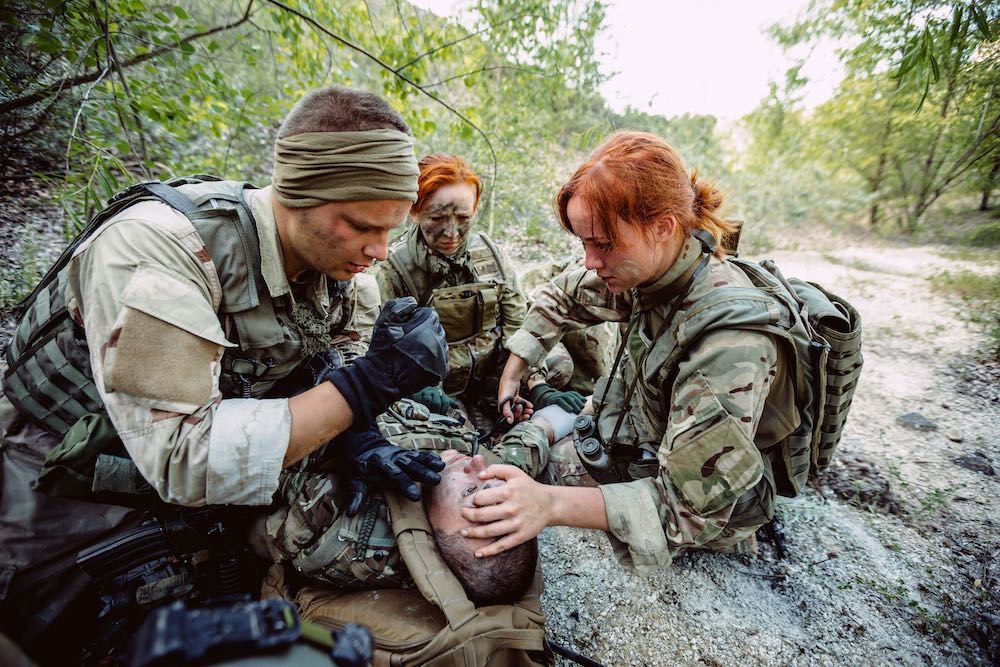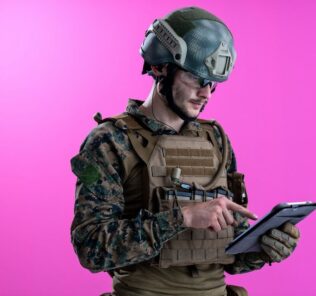U.S. DoD JETS Project Connects Multiple Commercial Clinical Simulation Systems Under One Dashboard
For years the United States military has been utilizing clinical simulation to help education and train service members and contractors. Specifically, as medical simulation has continued to evolve, the use of this training methodology has enabled these professionals to become better prepared in the event of a healthcare emergency. This HealthySimulation.com article shares how the United States Department of Defense is employing a particular project to connect multiple commercial clinical simulation systems under one dashboard. Through the use of this program, many digital training opportunities have come to fruition.
The DoD’s Military Health System (MHS) has a challenging mission which includes ensuring America’s 1.4 million active duty and 331,000 reserve-component personnel are healthy. The agency also works to ensure that all active and reserve medical personnel in uniform are trained, and ready, to provide medical care in support of operational forces around the world. Training used to ensure that these service men and women are ready for all real-world scenarios often involves healthcare simulation. This article discusses the U.S. Department of Defense’s (DoD) clinical training challenge involving the connection of commercial clinical simulation systems to create custom simulation environments.
*Editors Note: I cannot stress enough the importance interconnectivity will have in healthcare over the next century, which is all the more reason we at HealthySimulation.com are so interested in the JETS project. Obviously now we can see that a kind of “COVID Catalyst” forced many industry sectors to completely reconfigure operations around remote interaction. In the case of healthcare simulation then, the ability to manage multiple simulators, regardless of their modality, location and even brand, in-order to provide much needed emergency education and training would suddenly become extremely important — and especially — at scale. Enter JETS, a new dashboard being unveiled in the next few months which is designed to do all of the above, and more.
Sponsored Content:
The Patient Safety Movement Foundation is doing amazing work for the field of Patient Safety, which includes leading the charge for interconnectivity –or in their specific case the “Open Data Pledge“– enabling direct patient relevant communication between medical devices across competing brands.
Each day, the DoD’s MHS aims to provide a medical benefit commensurate with the service and sacrifice of more than 9.6 million active duty personnel, military retirees and their families. Further, MHS has to accomplish this mission on land, at sea, and in the air, in very diverse environments, ranging from civilian-type hospitals to remote locations under hostile and dangerous conditions. across the nation and around the world.
As a result of the enormous challenges of training, and maintaining the proficiency of such a large and diverse clinical workforce, the DoD was an early investor and adapter of medical simulation. Today, the DoD owns thousands of medical simulators and simulation support systems ranging from simple part task trainers to full body mannequins and holographic training suites.
What is JETS?
Sponsored Content:
Since 2016, the DoD has funded (1) IVIR Inc. to conduct research regarding the use of simulation to improve the care of patients under field conditions. IVIR’s efforts focused on patient care issues, associated Prolonged Field Care (PFC) scenarios, errors that can occur during the transfer of patients between roles of care, and the development of processes for networking commercial simulations and simulation support systems. The results of this research have led to the development of an advanced prototype of the JETS system.
The core functionality of JETS is that it allows current, commercial off-the-shelf, medical simulations, and simulation support systems, to communicate with each other, in a federated network, over a standard Internet or intranet connection. This allows multiple simulation components to be combined to create a training micro system representing a single, customized simulated patient. The program also allows simulated patients to be digitally transferred to other patient simulators as an analog of the transfer of real-world patients through the various MHS Roles of Care.
For example, assume there is a requirement to train a clinical team to be able to treat a patient for massive blood loss, identify when hypovolemic shock (2) secondary to the blood loss is occurring, and then transition to performing a Resuscitative Endovascular Balloon Occlusion of the Aorta (REBOA) (3). Currently, there is no single simulation system that can provide a high-fidelity simulation for this type of scenario.
However, by digitally connecting (for example) a TCCS Plus manikin to an Angio Mentor REBOA simulator, along with a physiology engine such as HumMod (4) to a JETS network, you now have a simulation training environment that supports training individual and collective (team) tasks for the full clinical situation in all of the domains of learning. Adding an After Action Review (AAR) system, such as SIMULATIONiQ Portable, to the JETS network creates a debriefing system that is not only capturing audio and video of the simulation session, but also receiving, and capturing data directly from the simulators to provide a complete instructional system!
Another example would be a medical training exercise where a front line medical unit at Fort Hood, TX, a helicopter medical evacuation unit at Fort Rucker, AL, and a field hospital at Joint Base Charleston, SC, want to train together to practice patient hand-offs (5) without leaving their home stations. Using a JETS network, the front line medic using a screen-based simulation, such as TC3 Sim, could perform the initial treatment of a left tib/fib fracture and then call for helicopter evacuation, using normal communications procedures. However, instead of physically transferring the patient on board a helicopter, the patient is digitally transferred into a SimMan 3G located in a mock up of a helicopter fuselage.
Here, air evacuation medics carry out en route stabilization on the simulated patient. Instead of physically flying the patient from Fort Rucker to Joint Base Charleston, the patient is digitally transferred into yet another manikin. At this point, the field hospital team realizes that the simulated patient has developed compartment syndrome (6) from the initial injury and requires a fasciotomy (7). A fasciotomy trainer can then be connected via JETS so the field hospital team can perform the procedure.
As illustrated in the example above, using a JETS network can help to replicate the type of training environment and context where patient hand-off errors can occur. It can provide opportunities for process error identification as well as performance improvement training — all without the need for units to leave their home station.
How does JETS work?
The JETS system developed by IVIR Inc. and its collaborators, uses the High Level Architecture (HLA) (8) standard, and an open source runtime infrastructure (RTI) (9), that each simulation system connects to. Each simulation system joining the JETS network requires software that enables it to communicate data within this RTI. The design is such that the JETS architecture does not require access to the proprietary computational engines of a commercial simulation or simulation component. This allows simulations to communicate, and simulated patients to be digitally transferred to other patient simulators, as an analog of the transfer of real-world patients through the various MHS Roles of Care.
JETS also allows multiple simulation systems to be integrated to provide enhanced training capabilities not normally available in a single system. The JETS network can also be compatible with other network protocols via a network gateway (10) or similar solution. This allows a JETS network to interact with other types of medical simulation systems using a different network protocol, such as the Advanced Modular Manikin, as well as current, and future, military tactical and strategic simulations.
JETS Project Current Status
IVIR Inc. will demonstrate the advanced JETS prototype to the DoD, in the next few months, and shortly after, will make final delivery. That final delivery will include all the information required to create a JETS network as well as what a manufacturer will need to make its products JETS compatible.
About IVIR Inc.
IVIR Inc. is a certified, Woman-Owned Small Business (WOSB) (11) located in Sarasota, FL. It is dedicated to Innovative Research and Information Visualization with emphasis on training effectiveness, program management, system engineering, and community healthcare and education. IVIR encompasses the use of applied science and research in all aspects of improving the performance of people and their organizations. IVIR Inc.’s primary focus is medical modeling and simulation in military, civilian and foreign healthcare training markets.
About the Author
William E. Lewandowski, MS — Lewandowski is currently Chair of the Board and Chief Operations Officer of IVIR Inc. He has over 32 years of experience in the design, development, implementation and evaluation of simulation in the aviation, defense and medical industries. He has 43 years of experience in all aspects of leadership, management, planning and project management in military, private and public sectors. Lewandowski has published and presented in a number of international peer-reviewed venues on both simulation and instructional design and has served in an advisory capacity on these subjects to various U.S. and International clinical boards and societies. Lewandowski’s professional affiliations include the National Defense Industrial Association (NDIA), the Simulation Interoperability Standards Organization (SISO) and the Society for Simulation in Healthcare (SSH) on which he has served on the Board of Directors, as Chair of the Corporate Council, and he is currently a member of its Governance Committee.
Disclaimers and Acknowledgments
This effort is sponsored by the U.S. Government under Other Transactions Number W81XWH-15-9-0001. The U.S. Government is authorized to reproduce and distribute reprints for Governmental purposes notwithstanding any copyright notation shortly after that. The views and conclusions contained herein are those of the authors and should not be interpreted as necessarily representing the official policies or endorsements, either expressed or implied, of the U.S. Government.
Learn More About iVIR
- https://www.ivirinc.com/ourprograms/
- https://www.webmd.com/a-to-z-guides/hypovolemic-shock
- http://www.surgicalcriticalcare.net/Guidelines/REBOA%202018.pdf
- https://www.frontiersin.org/articles/10.3389/fphys.2011.00012/full
- https://www.medicalmutual.com/risk/practice-tips/tip/handoff-communication/64
- https://my.clevelandclinic.org/health/diseases/15315-compartment-syndrome
- https://emedicine.medscape.com/article/1894895-overview
- https://en.wikipedia.org/wiki/High_Level_Architecture
- https://en.wikipedia.org/wiki/Run-time_infrastructure_(simulation)
- https://www.lifewire.com/definition-of-gateway-817891
- https://www.sba.gov/federal-contracting/contracting-assistance-programs/women-owned-small-business-federal-contracting-program
William E. Lewandowski, MS is currently Chair of the Board and Chief Operations Officer of IVIR Inc. He has over 32 years of experience in the design, development, implementation and evaluation of simulation in the aviation, defense and medical industries. He has 43 years of experience in all aspects of leadership, management, planning and project management in military, private and public sectors. Lewandowski has published and presented in a number of international peer-reviewed venues on both simulation and instructional design and has served in an advisory capacity on these subjects to various U.S. and International clinical boards and societies. Lewandowski’s professional affiliations include the National Defense Industrial Association (NDIA), the Simulation Interoperability Standards Organization (SISO) and the Society for Simulation in Healthcare (SSH) on which he has served on the Board of Directors, as Chair of the Corporate Council, and he is currently a member of its Governance Committee.
Sponsored Content:





















